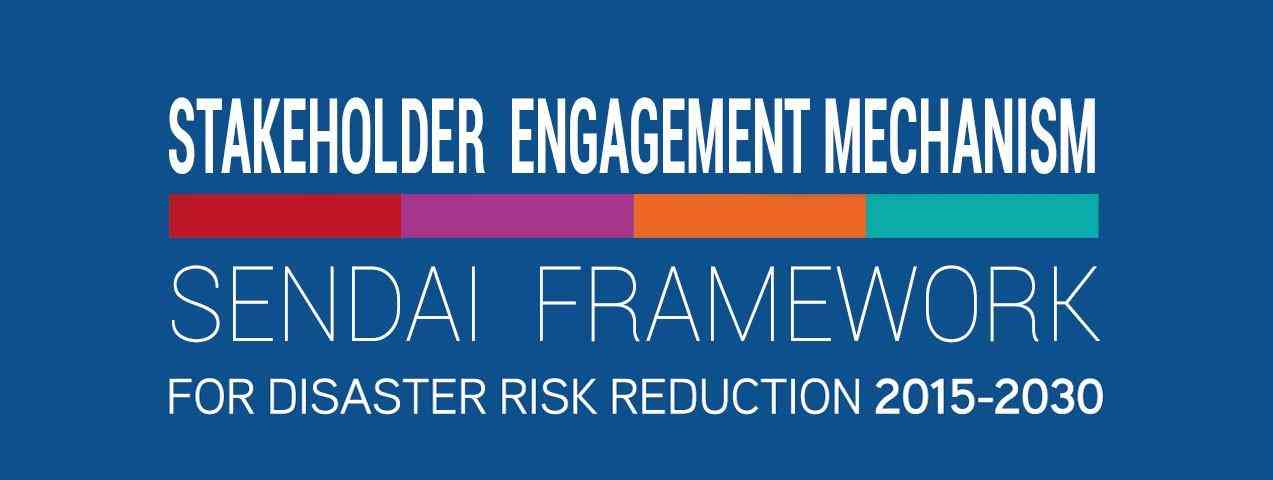Coordination of the Stakeholder Engagement Mechanism (SEM) of UNDRR
Coordinating the UNDRR Stakeholder Engagement Mechanism (SEM), including developing and implementing the SEM Action Plan 2024-2025. Conducting its internal governance to improve SEM structure, coordination and effectiveness, and support the development of inclusive stakeholder engagement governance at all levels.
Description
The UNDRR Stakeholder Engagement Mechanism (SEM) offers all non-state actors an opportunity to engage in the follow-up and implementation of the Sendai Framework. It creates an open and structured avenue to leverage the voice and action of stakeholders in support of the implementation of the Sendai Framework and integration of disaster risk reduction, prevention and resilience, and systemic into the broader 2030 Agenda.
The United Nations Office for Disaster Risk Reduction (UNDRR) Stakeholder Engagement Mechanism (SEM) is the main interlocutor between UNDRR and stakeholders, key functions of the UNDRR-SEM include to:
● Build an inclusive and broad movement for the implementation of the Sendai Framework;
● Create avenues to influence policy design and implementation;
● Strengthen citizen-led and social accountability mechanisms;
● Promote coordination, information exchange and harmonisation between stakeholder groups.
Activity 1. Organisation of annual SEM meeting and regular reporting
Activity 2. Enhance dedicated online space for SEM to provide members with easy access to materials and exchanges and increase SEM’s visibility to the outside world
Activity 3. Convene regular meetings of the Advisory Group, SEM, and regional counterparts.
Activity 4. Regularly enhance the awareness of SEM to stakeholders, donors, governments, UNDRR and the wider UN system
Activity 5. Support the development of enhanced inclusive and clear governance of stakeholders' engagement mechanisms at all levels
Activity 6. Disseminate standards of stakeholder engagement, and assess SEMs' work against them
Activity 7. Assess SEM membership and encourage a constituency-based approach
SEM is composed of 17 Stakeholder Groups that facilitate the development of the SEM Action Plan. Any SEM member can lead/support the implementation of the Action Plan activities.
Did the Sendai Framework change or contribute to changes in your activities/organization? If so, how?
The Sendai Framework elaborates on the role of stakeholders in the follow-up and implementation of the Framework in the Preamble, with further details set out in Section V. The United Nations Office for Disaster Risk Reduction Stakeholder Engagement Mechanism (UNDRR-SEM) was created in 2019, to institutionalise a space for non-state stakeholders to take part in the implementation, follow-up and review of the Sendai Framework for Disaster Risk Reduction (Sendai Framework).
What led you to make this commitment/initiative?
What was your position before making this Voluntary Commitment / prior to the Sendai Framework?
There was limited and uncoordinated DRR non-state actors' engagement within the UN system. The creation of UNDRR SEM provides an official, formal, and self-organised space for non-state stakeholders to contribute to and engage in formal/informal processes of Sendai Framework implementation, follow-up and review, including engagement with UNDRR.
Deliverables and Progress report
Deliverables
Deliverables are the end-products of the initiative/commitment, which can include issuance of publications or knowledge products, outcomes of workshops, training programs, videos, links, photographs, etc.
The SEM Advisory Group (AG) facilitates the development of the Action Plan and volunteers for activity leadership. Any SEM member can lead or support the implementation of the Action Plan activities. The contribution of all members is important for the development of the activities and for the exchange of knowledge and opinions. If you are a SEM member and wish to support and wish to lead and/or support, please reach out to the activity lead or SEM co-chairs. The Action Plan has core activities to reflect any prioritisation in the allocation of time and resources, in case limited, and to ensure that the focus and activities continuously reflect any changing requests and motivation from the membership.
The SEM Action Plan 2024-2025 consists of Four Action Areas in which several Activities are specified.
Developing a document "SEM Value Proposition" to present: 1)Who we are, 2) What we believe in, 3) Our Mission, 4) Objectives of SEM, 5) Added Value of Engaging SEM, and 6) Added Value to collaborate with SEM. So that the document will facilitate understanding towards the SEM and mobilize more partners to be engaged in SEM.
Organizations and focal points
Implementing Organization(s)
Focal points
